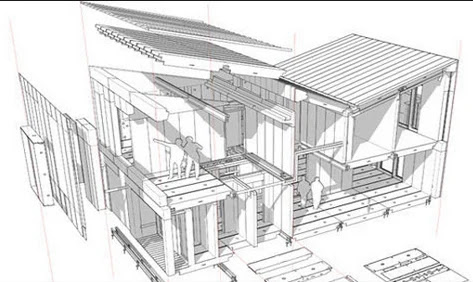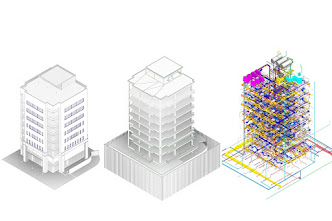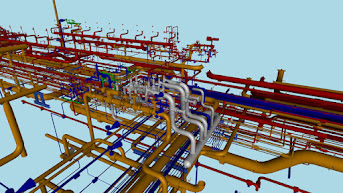How Architectural CAD BIM Can Improve Collaboration Among Architects, Engineers, and Drafters.
This blog post explores how architectural CAD BIM might enhance communication between drafters, architects, and engineers.
When architecture, collaboration is essential. To successfully execute a project, architects, engineers, and constructors must work together well. Fortunately, contemporary technology has made it easier for these professionals to collaborate. Architectural CAD BIM is a useful tool for this since it improves collaboration between architects, engineers, and building professionals.
Architectural CAD BIM is a fantastic technological tool made by Silicon Valley Infomedia Pvt. Ltd. It assists those in the development industry in creating computer images of buildings that are both flat (2D) and 3D, like a small model. BIM is widely used in the structure industry because of its current surge in popularity. It helps engineers, builders, and architects to accomplish their jobs more effectively.
Drawing and producing comprehensive building blueprints is important in the building industry. It's similar to creating a roadmap outlining how a building should be constructed, from the 2D blueprint (like a conventional drawing) to the complete 3D model (like a miniature replica). Building secure, useful structures requires the entire process.
Here's when BIM enters the picture. Building information modelling is what BIM stands for, but we might just think of it as a really helpful computer tool. It makes it easier for builders, engineers, and architects to collaborate. If each member of a team had their own piece of the jigsaw, BIM would act as the glue holding everything together.
What is Architectural CAD BIM?
Architectural Computer Aided Design BIM is a digital technique in our building industry. It generates detailed digital blueprints and 3D models, making planning and construction easier. Architects, engineers, and builders may work in a single digital platform, detecting and correcting issues as they arise. Changes are made quickly, which aids in the management of costs and timelines. BIM even allows you to virtually test out your building. It's like a Swiss army knife for development, making the entire process faster, more efficient, and environmentally benign.
This section entails using computer software for creating accurate and exact 2D and 3D building drawings and designs. CAD technologies enable architects and designers to draw and visualize architectural plans.
BIM elevates CAD by incorporating intelligent data and information into digital models. It provides information on materials, pricing, timetables, and how various components of a building interact. BIM allows designers, engineers, laborers, and other stakeholders to collaborate throughout the lifecycle of a project, from design to operation and maintenance.
How is Architectural CAD BIM helping in making Architectural 2D Drafting?
Architectural CAD (Computer-Aided Design) and BIM (Building Information Modelling) are strong tools that aid in the creation of architectural 2D drafting. Here's how they can assist:
CAD and BIM tools give a digital platform for architects to create 3D models of buildings and structures. These 3D models are easily visualized and edited, allowing architects to experiment with design ideas and concepts before committing to 2D drawings.
CAD and BIM tools provide architects with a digital platform for creating 3D models of buildings and structures. These 3D models are easily visualized and modified, allowing architects to test design ideas and concepts in a virtual setting before committing to 2D drawings.
CAD and BIM technologies make the drafting process easier. Architects may directly generate 2D drawings from 3D models, eliminating the need for manual drafting. This saves time and reduces the possibility of mistakes connected with manual drafting.
What is Architectural 2D Drafting?
Architectural 2D drafting is the process of producing two-dimensional (2D) technical drawings, plans, and diagrams that show the structure's design, layout, and specifics. In the world of architecture and construction, these drawings act as a crucial form of documentation and communication.
Architectural 2D drawing is essential to the design and construction of buildings. It ensures that a project is produced accurately and by the planned design by acting as a means of communicating the architect's vision to clients, contractors, and builders. These drawings are also essential to applying for permits, calculating costs, and keeping track of the project's advancement and modifications. Building information modeling (BIM) and computer-aided design (CAD) tools have improved both the precision and the effectiveness of the process of developing and managing architectural 2D drafting.
How Architectural CAD BIM Can Improve Collaboration Among Architects, Engineers, and Drafters is described in the stages below.
Improved Coordination and Communication
Using one location, architects, engineers, and contractors may collaborate on a project with the use of architectural 2D drafting services. This unique location functions as a central hub where everyone can deposit their project materials, view them, and make immediate changes. This handy feature eliminates the need for several copies of the same document, reducing the likelihood of errors and misunderstandings.
The BIM model can contain both architectural 2D drafting and architectural 2D drafting & detailing services. This enables a more comprehensive view of the project before it is built. It's similar to having a crystal-clear vision of how the structure would appear. This facilitates greater communication and understanding among all project participants. Therefore, everyone is aware of what is occurring and what needs to be done to complete the project successfully.
Improved Collaboration and Integration
Using Architectural 2D Drafting Services, suppliers, engineers, and architects may collaborate on the same platform. They can combine various project components right away thanks to this platform. For instance, those responsible for the structure of the building may combine their ideas with those depicted in the architectural designs. The contractors can synchronize their project schedules with 3D models at the same time. All of this makes it easier to manage and monitor the project's progress.
To create 3D models, architectural 2D drafting services can be used. The BIM model, which is similar to an extremely detailed project plan, can be enhanced with these 3D models. Everyone involved gains a greater understanding of the project when they can view these 3D models. This knowledge makes it simpler for them to operate as a team, identify issues, and resolve them before they worsen.
Improved Cost Control
Architectural 2D Drafting Services are quite useful for managing the project's finances. They can assist you in analyzing the prices and offer you a very accurate sense of what everything will cost. For those in control of the project's budget, such job management is incredibly useful.
Those workers can use the BIM model to detect potential cost overruns and adjust their budget accordingly to keep expenses under control.
Very detailed drawings are produced with the use of architectural CAD 2D drafting & detailing services. The BIM model may incorporate these drawings, providing all parties with incredibly specific information about things like supplies, how much of them we'll need, and how much everything will cost.
We can use this information as a road map to make sure we're not overspending. It enables us to accomplish the project within our budget and make wise decisions.
Improved Efficiency and Productivity
The use of architectural 2D drafting services can improve and speed up operations. Because they can perform repetitive tasks automatically, there will be fewer mistakes and subsequent problems to repair. This is especially advantageous for engineers and architects who have to produce challenging ideas and drawings. They can complete tasks more quickly as a result.
3D models can be created using architectural 2D drafting services, and BIM software then enables such models to do tasks automatically. This helps to speed up the process of creating intricate designs. Additionally, when processes are automatic, drawings are produced correctly and consistently each time, resulting in fewer errors and less need for subsequent corrections.
Improved Quality Control
Architectural CAD BIM functions as a supreme tool that ensures the quality of every aspect of a project. It provides a broad overview of the project so that all parties can see issues before they become major challenges. Building workers, engineers, and architects can all collaborate on the project at once. By doing so, they can make sure that everything fits together flawlessly and operates without a hitch.
Very precise drawings and models are created with the aid of architectural drafting and modeling services. BIM software can be used to look at and verify these. This aids in identifying issues and errors early on for all parties participating in the project. It improves the project and reduces the possibility that it may take longer or spend more money than anticipated.
Building teamwork is made possible by architectural 2D drafting services, which are like a magic wand that can be manipulated. They establish a single location where workers, engineers, and architects can collaborate and operate effectively together. This makes it much simpler to communicate, share, manage expenses, work quickly, and ensure that everything is of the highest caliber.
These various architectural services can all be included in the BIM model. This implies that accurate information and precise drawings are always visible to all parties. It's like having a crystal-clear, current structure that makes it easier for everyone to collaborate.
Professionals must embrace new technology like BIM as the building enterprise is always evolving. This improves their ability to collaborate and ensures the success of undertakings. With the use of architectural CAD BIM, builders, engineers, and architects can collaborate, identify issues early on, and produce excellent projects that agree with clients.



Comments
Post a Comment